欧洲文化入门Europe Culture3 The Middle Ages
- 格式:ppt
- 大小:1.78 MB
- 文档页数:34
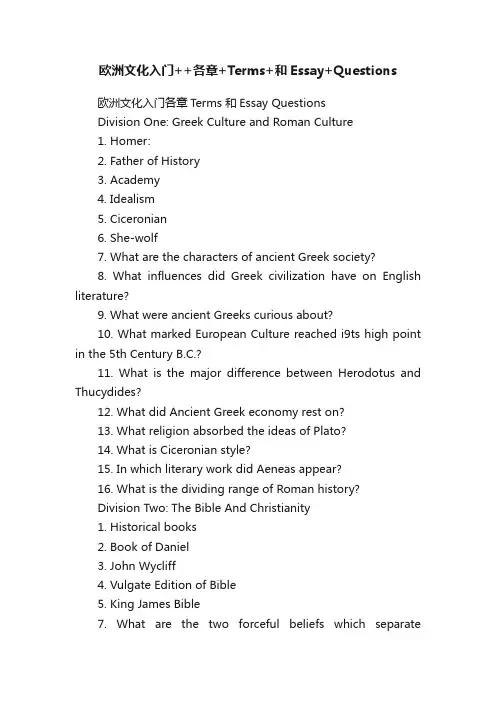
欧洲文化入门++各章+Terms+和Essay+Questions欧洲文化入门各章T erms 和Essay QuestionsDivision One: Greek Culture and Roman Culture1. Homer:2. Father of History3. Academy4. Idealism5. Ciceronian6. She-wolf7. What are the characters of ancient Greek society?8. What influences did Greek civilization have on English literature?9. What were ancient Greeks curious about?10. What marked European Culture reached i9ts high point in the 5th Century B.C.?11. What is the major difference between Herodotus and Thucydides?12. What did Ancient Greek economy rest on?13. What religion absorbed the ideas of Plato?14. What is Ciceronian style?15. In which literary work did Aeneas appear?16. What is the dividing range of Roman history?Division Two: The Bible And Christianity1. Historical books2. Book of Daniel3. John Wycliff4. Vulgate Edition of Bible5. King James Bible7. What are the two forceful beliefs which separateChristianity from other religions?8. What influences did Bible have on western culture?Division Three The Middle Ages1. Age of Faith2. Feudalism3. Father of the church4. City of God5. Benedictine Rule6. Crusades7. Carolingian Renaissance8. Alfred the Great9. What are the main elements of humanism?10. What are the doctrines of Martin Luther?11. What was the significance of the Reformation in European civilization?12. Why we call Renaissance a turning point in modern history?Division Four Renaissance and Reformation1. Renaissance2. Mona Lisa3. Elegant Raphael4. Titian5. Calvinism6. Reformation7. Counter Reformation8. What are the main elements of humanism?9. What are the doctrines of Martin Luther?10. What was the significance of the Reformation in European civilization?11. Why we call Renaissance a turning point in modernhistory?Division Five The Seventh Century1. Induction and deduction2. Induction and Deduction3. Leviathan4. Bill of Right5. Paradise Lost6. Cartesian Doubt7. Dualism8. French Classicism9. What were Galilio’s contributions to the modern science?10. Why we call Newton the greatest scientist that ever lived?11. What were the major difference between Locke’s concept and Hobbes’?12. What were the main features of seventeenth century?Division Six1. Age of Reason2. The Spirit of Laws3. Letter Anglaise4. Candide5. Rou sseau’s Social Contract6. Robinson Crusoe7. Sorrow of Young Werther8. Faust9. Cabal and Love10. Critique of Reason11. Nebular Hypothesis12. Why we call Enlightenment an age of reason?What is the great significance of the Industrial Revolution?Division Seven1. Romanticism2. The Lakers3. What are the main features of Romanticism?4. What are the main differences between Romantics and Realists?5. What were the conditions in western Europe in the 1840’s?6. Why Mark Twain is considered the father of American Literature?Division Eight1. Marxism2. Capital3. Utopian Socialism4. Origin of SpeciesDivision Nine1. Realism2. Balzac3. Madame Bovary4. A Hunter’s Sketches5. David Copperfield6. Middlemarch7. Vanity Fair8. Uncle Tom’s Cabin9. Impressionism10. Post ImpressionismDivision Ten1. Modernism2. Sigmund Freud3. Odepus Complex4. Waste Land5. Ulysses6. The Lost Generation7. Angry Young men in England8. Beat Generation9. Black Humor10. Fauves11. Expressionism12. Cubism13. Futurism14. Dadaism15. Surrealism。

欧洲文化史欧洲文化略分五个时期。
一、古典时期( the Classic Age, 1200 B.C~476 A.D)主要是古希腊文明(the Ancient Greek Civilization)及古罗马文明(the Ancient Roman Civilization)。
奉行的是异教徒的信仰和实践(Paganism)。
异教徒指非基督教徒,非犹太教徒,非伊斯兰教徒。
理念上鲜有束缚,实践中享受人生,个性突出,热情奔放,创造力旺盛,风格多姿多彩。
二、中世纪时期(the Middle Ages, 476~1453)主要是罗马天主教的教会文化(the Church Culture),强调人的原罪(the original sin),人性受到压抑(inhibited),文化上是一泓死水(cultural backwater)。
这一时期的主流是对古典时期的反动。
反主流的代表人物是但丁( Alighier,Dante,l265~1321),杰作是史诗《神曲》(Divine Comedy)。
三、文艺复兴时期(the Renaissance, 15~16C)古典主义的复兴,遵循的是人文主义(Humanism),这是对中世纪经院哲学(Scholasticism)的对抗(reaction)。
代表人物有:1. 米开朗琪罗(Michelangelo Buonarroti,1475~1564):代表作有梵蒂冈教皇(Pope,pontiff)专用西斯庭小教堂(The Sistine chapel)穹顶上的壁画《创世纪》,(Genesis)以及圣坛后的壁画《最后的审判》(The Last Judgment),雕塑《大卫》(David)等。
米氏又是建筑师、诗人。
2. 达芬奇(Leonardo da Vinci,1452~1519):代表作有《蒙娜丽莎》(Mona Lisa),《最后的晚餐》,(The last Supper)。
是画家,又是雕塑家、建筑师、音乐家、工程师,确是多才多艺(versatile)。
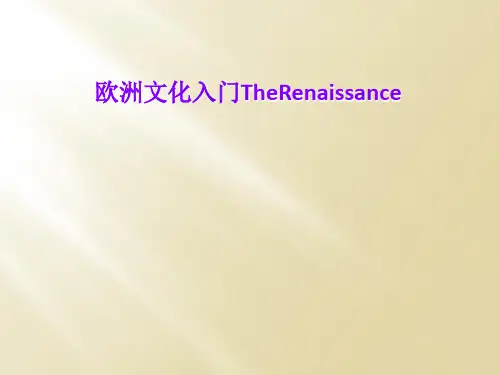
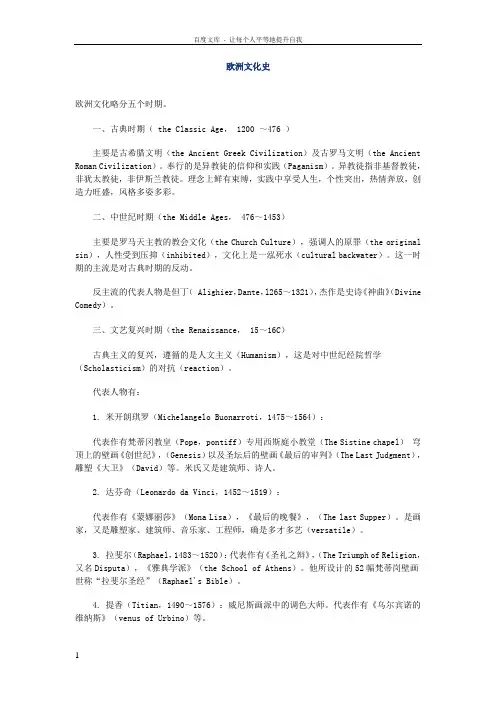
欧洲文化史欧洲文化略分五个时期。
一、古典时期( the Classic Age, 1200 ~476 )主要是古希腊文明(the Ancient Greek Civilization)及古罗马文明(the Ancient Roman Civilization)。
奉行的是异教徒的信仰和实践(Paganism)。
异教徒指非基督教徒,非犹太教徒,非伊斯兰教徒。
理念上鲜有束缚,实践中享受人生,个性突出,热情奔放,创造力旺盛,风格多姿多彩。
二、中世纪时期(the Middle Ages, 476~1453)主要是罗马天主教的教会文化(the Church Culture),强调人的原罪(the original sin),人性受到压抑(inhibited),文化上是一泓死水(cultural backwater)。
这一时期的主流是对古典时期的反动。
反主流的代表人物是但丁( Alighier,Dante,l265~1321),杰作是史诗《神曲》(Divine Comedy)。
三、文艺复兴时期(the Renaissance, 15~16C)古典主义的复兴,遵循的是人文主义(Humanism),这是对中世纪经院哲学(Scholasticism)的对抗(reaction)。
代表人物有:1. 米开朗琪罗(Michelangelo Buonarroti,1475~1564):代表作有梵蒂冈教皇(Pope,pontiff)专用西斯庭小教堂(The Sistine chapel)穹顶上的壁画《创世纪》,(Genesis)以及圣坛后的壁画《最后的审判》(The Last Judgment),雕塑《大卫》(David)等。
米氏又是建筑师、诗人。
2. 达芬奇(Leonardo da Vinci,1452~1519):代表作有《蒙娜丽莎》(Mona Lisa),《最后的晚餐》,(The last Supper)。
是画家,又是雕塑家、建筑师、音乐家、工程师,确是多才多艺(versatile)。
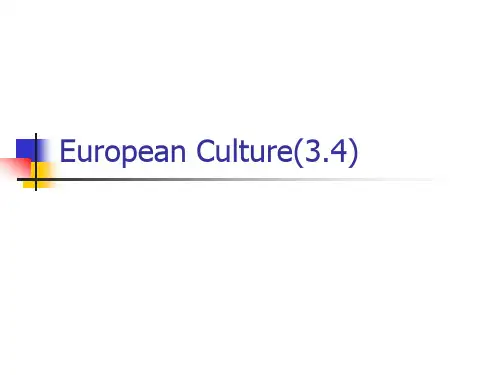
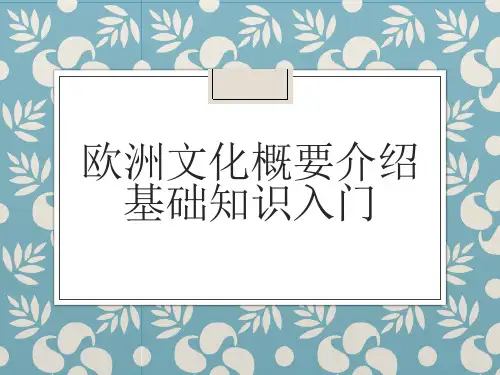
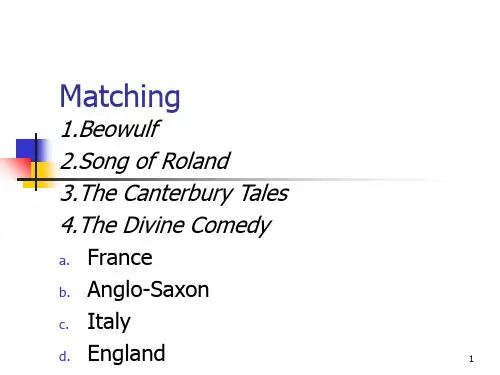

【最新整理,下载后即可编辑】我衷心祝愿你们成为我的校友-路明军欧文各单元重要人物及其代表作(敬请同学们提意见、建议,不断改进)1Greek and Roman culture1.1 Greek (5century BC)1, Homer, wrote: epic: Iliad ; Odyssey2, Sophocles, wrote: drama : Oedipus the King, Electra, Antigone (都是人名)3, Aristophanes, wrote: comedy: Frogs, Clouds, Wasps and Birds4, Historian:Herodotus ( the father of history)Thucydides, wrote: the war between Athens and S-parta and between Athens and Syracuse)5, Ancient Greek philosopher:Pythagoras(founder of scientific mathematics),Heracleitus ( “ all is flux, nothing is stationery),Democritus( one of the earliest exponents of the atomic theory)Socrates ( founder of dialectical method辩证法), Plato’s teacherPlato: Dialogues( founder of Idealism), Aristotle’s teacherAristotle: Ethics, Politics, Poetics RhetoricSophists(诡辩派): Protagoras(人名,下同)Cynics(犬儒派): DiogenesSceptics(怀疑派): PyrrhonEpicureans: EpicurusStoics(斯多葛派): Zeno6,ScienceEuclid : wrote: Elements(几何原理)Archimedes:” give me a place to stand, and I will move the world”, illustrates the principle of the lever.7, Art and etc.Parthenon(巴台农神庙)The Acrpolis (阿波罗神庙)重要年代:1, Greek culture reached a high point of development in the 5th century B.C. 2, the Olympic games revived in 1896.3,Homer probably lived around 700 BC.4,Euclid and Archimedes both lived in the 3rd century BC.5, in 146 BC the Romans conquered Greece.1.2 Rome (after 146 BC)8, 名句:the Roman writer Horace said, “captive Greece took her rude conqueror captive”9, Latin literatureProse:Marcus Tullius CiceroJulius Caesar: Commentaries (高卢战记)名句:I came, I saw, I conquered. 10,PoetryLucretius wrote : on the nature of things11, ArchitecturePantheon ( 万神殿)12.SculptureShe-wolf重要年代:1,the burning of Corinth in 146 BC marked Roman conquest of Greece.2, in 476 the last emperor of the West Roman was deposed by the Goths and this marked the end of the West Roman Empire.3, the East Roman Empire collapsed when Constantinople fell to the Turks in1453.2 The Bible and Christianity (The Old Testament about 1300 BC; The New Testament about 400 AD)1,The Old Testament became the first part of the Christian Bible and the New Testament the second.2, Christian are divided into 3 groups: Catholic, orthodox and protestant3, the first English version of whole Bible was translated from the Latin Vulgate (拉丁文圣经) in 1382 and was copied out by hand by the early group of reformers led by John Wycliff.4, the most important and influential of English Bible is the “authorized ”or King James’ version.重要年代:The Old Testament formed in about 1300 BC; The New Testament formed in the end of the 4th century.3 The Middle ages (between 476 AD and 17th century)1,The most important of all the leader ops Christian thought was Augustine(人名) of Hippo(地名)who lived in North Africa in the 5th century. He wrote: the Confession and the City of God.2,Alfred the Great promoted translations into the vernacular form Latin works, he inspired the compilation of the Anglo –Saxon Chronicles(编年史).3, St. Thomas Aquinas Italian philosopher , he wrote: Summa Contra Gentiles ( 驳异教徒),Summa Theologiae (神学大全)4, Roger Bacon, wrote: the Opus maius( 大著作), an encyclopedia of the sciences of his time.5, Beowulf is an Anglo- Saxon epic, originating from the collective efforts of oral literature.6, Dante Alighieri,the greatest poet of Italy, wrote: the Divine Comedy(I神曲).7, Geoffrey Chaucer, English poet, wrote: the Canterbury Tales (坎特伯雷故事集).重要年代:1, in 476 AD a Germanic general killed the last Roman emperor and took control of the government.2, after 1054, the church was divided into the Roman Catholic church and the Eastern Orthodox church.4 Renaissance and reformation (between 14th and 17th century) 1.Leonardo da Vinci , Italian, painted : Last Supper, Mona Lisa2, Michelangelo Buonarroti, Italian, sculpture: David, painted: Sistine Chapel(西斯廷礼拜堂), Dying slave, Moses.3,Raphael, Italian, painted: Madonna ( virgin girl), School of Athens4,Titian, Venetian, painted: The venus of Urbino, Sacred and Profane Love, Madonna of the pesaro Family, Man with the Glove5, John Wycliffe ( religious reformer), English , led the translation of the Bible into English for the first time.6, Jan Hus ( religious reformer), Bohemian Czech reformer7, Martin Luther, German leader of the Protestant reformation: 95 theses8, John Calvin, French theologian: Institutes of the Christian Religion9, Francois Rabelais, French, wrote: Gargantua and Pantaguel (巨人传)10,Miguel de Cervantes, Spanish novelist, wrote: Don Quixote(唐. 吉柯德) 11,El Greco, Spanish painter, painted: The Burial of Count Orgaz (奥加兹伯爵的葬礼)12,William Shakespeare, English writer: Hamlet, As you like it, Twelfth night, Othello, King Lear, and Macbeth .13, Christopher Columbus, Genoese-born navigator and discoverer of the New World.14, Bartholomeu Dias, Portuguese navigator, discovered the Cape of Good Hope in 1487.15, Vasco da Gama, Portuguese navigator, discovered the rout to Indea roundthe Cape of the Cape of Good Hopes16, Amerigo Vespucci, Italian navigator in his honor America was named. 17,Nicolaus Copernicus, Polish astronomer, wrote: De Revolutionibus Orbium(天体革命,即the revolution of the heavenly orbs也译为天体运行论), the father of modern astronomy.18, Dante , Italian poet, wrote: Divine Comedy.19,Niccolo Machiavelli, he was called the father of political science, wrote: Price( 论王公), Discourses(论文集).重要年代:1,Renaissance and reformation took place between 14th and 17th century.2, the discovery of America in1492 , the discovery of the Cape of Good Hope in 1487, and the rounding of the Cape of Good Hope to India in between the years of 1497 and 1498.5 The 17th Century ( the beginning of modern time)1,Johannes Kepler, German scientist, discovered the 3 laws of planetary motion( what are the 3 laws ?)2, Galileo Galilei, Florentine ( 弗罗伦萨人),scientist, wrote: Sidereus Nuncius (i.e. The Starry Messenger,星星使者), applied telescope to the study of skies, proved geocentric system was wrong, discovered the importance of acceleration in dynamics, discovered the law of inertia, first established the law of falling bodies.3, Sir Isaac Newton, English scientist, invented calculus, discovered that whit light is composed of all the colors of the spectrum, the most important discovery is the universal gravitation.4, Francis Bacon, English philosopher, essayist and statesman, found modern inductive method(归纳法), wrote: The Advancement of Learning, The New Atlantes, The New Method, Essays, 名句:Knowledge is power, The Monuments of wit survive the monuments of power ( 智慧的力量比统治的力量更长久).5, Thomas Hobbes, English political philosopher, , wrote: Leviathan( 利维坦), he was a materialist.6, John Locke, English empiricist and an outstanding political philosopher, wrote: Essay concerning human understanding, Treatises of civil government. 7, John Milton, English writer and political figure, wrote: Paradise lost, Paradise Regained and Samson Agonistes.8, Descartes, French philosopher, wrote: Rules for the Direction of the Mind, Discourse on Method , Meditations concerning first philosophy and objections and replies.9, Moliere, French author, wrote: Tartuffe, Le Misanthrope and L’Avare. 10, Michelangelo Caravaggio, Italian painter, painted: The Calling of St. Matthew, The Cardsharps( 玩牌者)11,Van Rijn Rembrandt, Dutch Baroque painter etcher, painted: Blinding of Samson, The Polish Rider.重要年代:1,in the 17th century Europe advanced from the Middle Ages to the modern times.6 The age of enlightenment (the second half of the 18th century)1, B. Montesquieu, French philosopher, man of letters, wrote: Persian letters, The spirit of the laws.2, Voltaire, French poet, dramatist, historian, and philosopher, wrote: Lettres anglaise ( also circulated as Lettres philosophiques哲学书简), Candide(憨第德)3,J. J. Rousseau, Swiss-born philosopher, author, political theorist and composer, wrote: The origin of human inequality(论人类不平等起源), The social contract, The confessions(忏悔录)4,D. Diderot, French philosopher and man of letters, wrote: Philosophical thoughts, Encyclopedia, Elements of Physiology, Rameau’s nephew.5,Daniel Defoe, English novelist and political journalist, wrote: The life andstrange surprising adventures of Robinson Crusoe, of York, Mariner, The Fortune and misfortunes of the famous Moll Flanders , A journal of the plague year, The fortune mistress.6, J. Swift, English churchman, political writer and poet, wrote: A modest proposal, Gulliver’s travels( 格列弗游记)7,Henry Fielding, English novelist, dramatist and essayist, wrote: The history of the adventures of Joseph Andrews and his friend Mr. Abraham Adams, The life of Mr. Jonathan Wild the Great, The history of Tom Jones, a Foundling.8, Wolfgang Goethe, German poet, wrote: The sorrows of young Werther, Wilhelm Meister’s travels( 威廉迈斯特的漫游时代),Faust,(浮士德).9, J. Schiller, German dramatist ,poet, historian and aesthetic theoretician, wrote: Cabal and love,Wilhelm Tell(威廉退尔).10, I. Kant, German classical philosopher, wrote: Critique of pure reason ( 纯理性的批判).11, J. Bach, German musician, wrote: Brandenburg concertos12, G. F. Handel, born in German, naturalized English, wrote: Oratorios,Messiah(清唱剧,弥赛亚).13, J. Haydn, wrote: Austrian composer, wrote: String quartets ( 弦乐四重奏). 14, W.A. Mozart, Austrian composer, wrote: Choral music Requiem, k. 626( 安魂曲),The Marriage of Figaro(费加罗的婚礼).重要年代:1,the American war of independence of 1776 ended British colonial rule over that country.2, the French Revolution followed in 1789.3, the first French Republic was born in 1792.7 Romanticism (between the late 18th and the early 19th century)1, William Blake, English writer, wrote: Songs of innocence, Songs of experience, The French Revolution, Milton.2, the Lakers- Wordsworth and Coleridge.Wordsworth,he wrote: Bliss was it in that dawn to be alive, But to be young was very Heaven!( 能生活在那个黎明真是幸福,若到那时你还年轻则更是天堂!)Coleridge wrote: Kubla Khan ( 忽必烈汗), The Rime of the ancient mariner( 古舟子咏).3,George G. Byron, English poet, wrote: Isles of Greece, Don Juan( 唐. 璜). 4, Percy B. Shelley, English poet, wrote : Ode to the West wind (If winter comes, can spring be far behind?), Prometheus Unbound.5, John. Keats, English poet, wrote: Ode to a nightingale.6, Walter Scott, English poet, wrote: The heart of mid-Lothian(中洛辛郡的心脏), Ivanhoe( 艾凡赫,中译撒克逊劫后英雄略)。
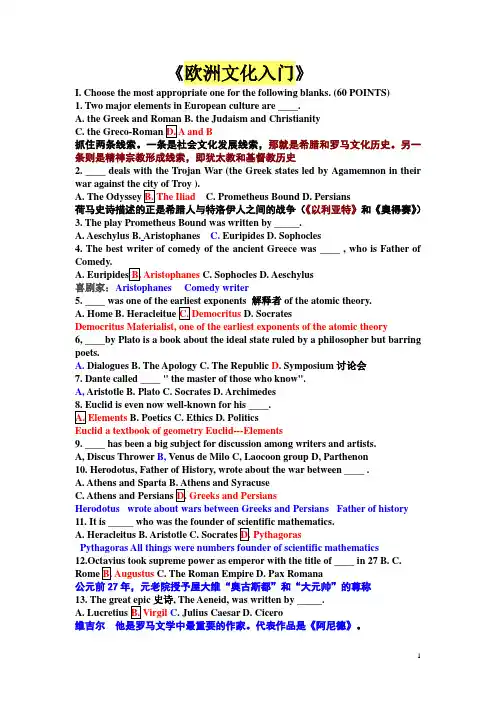
《欧洲文化入门》I. Choose the most appropriate one for the following blanks. (60 POINTS)1. Two major elements in European culture are ____.那就是希腊和罗马文化历史。
另一条则是精神宗教形成线索,即犹太教和基督教历史2. ____ deals with the Trojan War (the Greek states led by Agamemnon in theirC. Prometheus BoundD. Persians《以利亚特》和《奥得赛》)3. The play Prometheus Bound was written by _____.A. AeschylusB.AristophanesC. EuripidesD. Sophocles4. The best writer of comedy of the ancient Greece was ____ , who is Father of Comedy.C. SophoclesD. Aeschylus喜剧家:Comedy writer解释者of the atomic theory.D. Socrates6, ____by Plato is a book about the ideal state ruled by a philosopher but barring poets.A. DialoguesB. The ApologyC. The RepublicD. Symposium讨论会7. Dante called ____ " the master of those who know".A, Aristotle B. Plato C. Socrates D. ArchimedesB. PoeticsC. EthicsD. PoliticsEuclid---Elements9. ____ has been a big subject for discussion among writers and artists.A, Discus Thrower B, Venus de Milo C, Laocoon group D, Parthenon10. Herodotus, Father of History, wrote about the war between ____ .Herodotus Father of historyA. HeracleitusB. AristotleC. SocratesC. The Roman EmpireD. Pax Romana年,元老院授予屋大维“奥古斯都”和“大元帅”的尊称史诗, The Aeneid, was written by _____.C. Julius CaesarD. Cicero维吉尔。

欧洲中世纪英文版In the annals of human history, the Middle Ages stand as a pivotal epoch, bridging the gap between the classical antiquity and the modern world. Spanning roughly from the 5th to the 15th century, this period witnessed a profound transformation of Europe, marked the fall of the Western Roman Empire, the rise of feudalism, the emergence of Christianity as a dominant force, and the birth of the nationstates.The Middle Ages were a time of great contrasts. While Europe was engulfed in the Dark Ages, with its share of political instability, economic hardship, and social strife, it was also a period of remarkable cultural and intellectual growth. The age saw the flourishing of monasticism, the establishment of universities, and the preservation and translation of ancient texts, which laid the foundation for the Renaissance that was to follow.The Middle Ages were also a time of great artistic achievement. Gothic architecture, with its soaring spires and intricate stained glass, became the dominant style of the period. The troubadours and minstrels of the Middle Ages contributed to the rich tapestry of European music, while theilluminated manuscripts and the Bayeux Tapestry remain testaments to the era's artistic prowess.。
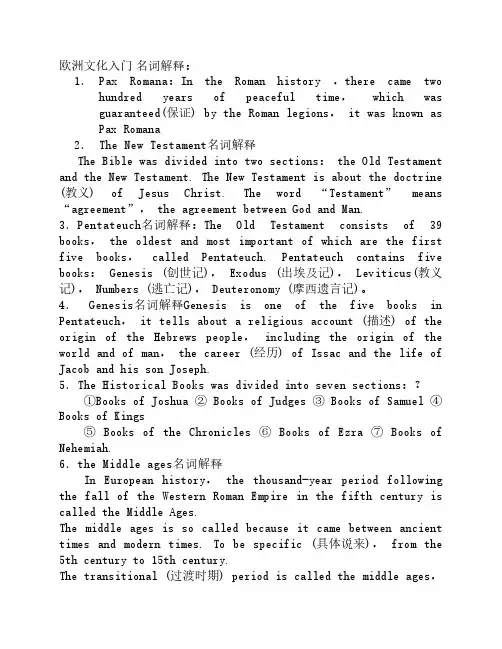
欧洲文化入门名词解释:1. Pax Romana:In the Roman history ,there came two hundred years of peaceful time, which wasguaranteed(保证) by the Roman legions, it was known asPax Romana2. The New Testament名词解释The Bible was divided into two sections: the Old Testament and the New Testament. The New Testament is about the doctrine (教义) of Jesus Christ. The word “Testament” means “agreement”, the agreement between God and Man. 3.Pentateuch名词解释:The Old Testament consists of 39 books, the oldest and most important of which are the first five books, called Pentateuch. Pentateuch contains five books: Genesis (创世记), Exodus (出埃及记), Leviticus(教义记), Numbers (逃亡记), Deuteronomy (摩西遗言记)。
4. Genesis名词解释Genesis is one of the five books in Pentateuch, it tells about a religious account (描述) of the origin of the Hebrews people, including the origin of the world and of man, the career (经历) of Issac and the life of Jacob and his son Joseph.5.The Historical Books was divided into seven sections:? ①Books of Joshua ② Books of Judges ③ Books of Samuel ④Books of Kings ⑤ Books of the Chronicles ⑥ Books of Ezra ⑦ Books of Nehemiah.6.the Middle ages名词解释 In European history, the thousand-year period following the fall of the Western Roman Empire in the fifth century is called the Middle Ages.The middle ages is so called because it came between ancient times and modern times. To be specific (具体说来), from the 5th century to 15th century.The transitional (过渡时期) period is called the middle ages,between ancient times and modern times. 7、Feudalism名词解释Feudalism in Europe was mainly a system of land holding (土地所有) — a system of holding land in exchange for military service (军事力量)。
I. General IntroductionIn European history, the thousand-year period following the fall of the Western Roman Empire in the fifth century is called the Middle Ages,also called Medieval times(476-1450). It is so called because it came between ancient times and modern times.In the latter part of the fourth century the Huns(匈奴人) swept into Europe from central Asia, robbing and killing as they came along, and large-numbers of the half civilized Germanic tribes such as the Visigoths, the Franks, the Angles and Saxons, and the Vandals fled(逃避) their homelands in northern Europe and were pushed to cross the Danube river*(多瑙河) into the territory(领土) of the Roman Empire. In A. D. 476 a Germanic general killed the last Roman emperor(君主) and took control of the government. While the Eastern Roman Empire continued, the power of ancient Rome was gone. In its place mushroomed a great many Germanic kingdoms, which in a few hundred years were to grow into the nations known as England. France, Spain, Italy, and Germany. Between the fifth and eleventh centuries, western Europe was the scene of frequent wars and invasions(战争和侵略). The political unity had given way to widespread destruction and confusion. Hunger and disease killed many lives; towns and villages fell into ruin and great areas of land lay waste.During the Medieval times there was no central government to keep the order. The only organization that seemed to unite Europe was the Christian church. It continued to gain widespread power and influence- In the Late Middle Ages,almost everyone in western Europe was a Christian and a member of the Christian Church.It is also known as the medieval period(1000), and as the Dark Ages(476-1000). As during the Middle times there wasno central government to keep the order, and the Christian church shaped people ’ s ideas and lives by taking the lead in politics, law, art, and learning of Europe, it is also called “ Age of Faith .”Whatever names we may give to this span of time, this is a period in which classical, Hebrew and Gothic heritages merged(传承、融合). And it is this fusion and blending of different ideas and practices 'that paved the way for the development of what is the present-day European culture.II . Manor and Church1. FeudalismFeudalism in Europe was mainly a system of land holding a system of holding land in exchange for military service. The word "feudalism" was derived from the Latin "feudum", a grant of land.a. Growth of FeudalismWhen the Western Roman Empire grew weak, people lived in constant danger of attacks from invaders and robbers. They had to find ways to protect their families and homes. Owners of small farms sought protection from large landowners, by giving them land and services; In return the large landowners promised to protect the landless peasants and their families. Besides, war had destroyed lots of towns, trade and business had declined, more and more townspeople fled to the countryside to seek protection from those powerful landowners. In this way, the large landowners came to own more and more and while the peas ants ended up giving the lords not only their land but their freedom as well. Most of them became serfs(农奴), bound to the land where they had been born. Only very fewpeasants were freemen, they were usually the workers who made the ploughs, shod the horses, and made harnesses for oxen and horses.Then in 732 Charles Martel, a Prankish ruler gave his soldiers estates known as fiefs as a reward for their service. They, granted the right to govern large sections of land as fiefs to great lords. These lords known as vassals in turn promised to fight for the king. And they themselves further granted parts of their fiefs to lesser vassals. Thus, a complicated system of government developed. After 800, the kings in Europe were usually very weak. Without a strong central government the kingdoms of Western Europe were divided into thousands of feudal manors or farming communities, each as big as an ancient polis. Some nobles grew more powerful than the king, and became independent rulers. They had the right to collect taxes and to make their own laws. Many of them coined their own money and raised their own armies. Therefore feudalism was also a system of government a form of local and decentralized government.b. The ManorThe centre of medieval life under feudalism was the manor. Manors were founded on the fiefs of the lords. Some lords owned only one manor; others owned many. They lived in a manor house. The manor(庄园主的住宅) house originally consisted of one big room with a high ceiling and astraw-covered floor. There nobles(贵族) met with vassals(奴仆), carried the laws and said their prayer. By the twelfth (第十二)century manor houses were made of stone and designed as fortresses(堡垒). They came to be called castles(城堡). Medieval Europe was dotted with castles. For instance in Germany alone [here were as many as 1 0 000 castles.Near the manor stood a small village of wood and dirt cottages with thatched roof. The village was surrounded by forests, meadows, pastures,and fields. Most village had a church, mill(作坊), bread oven(烤炉), and wine press. At the centre of the manor stood the church.c. Knighthood and Code of Chivalry(骑士!)Almost all nobles were knights in the Medieval days. But no one was born a knight ― knighthood had to be earned. The training was both long and hard. A noble began his education as a page at the age of seven. He was taught to say his prayers, learned good manners and ran errands for the ladies. At about fourteen, the page(学习骑士,接收训练期间做侍从,可以被训练为骑士) became a squire(地主,乡绅) or assistant to a knight (骑士) who became his master.学习骑士在十四岁的时候成为乡绅或者作为自己导师(也是骑士)的助手。